Stability Analysis of a TLP with Inclined Tension Legs under Different Marine Survival Conditions
Abstract
:1. Introduction
2. Model Establishment
2.1. Dynamic Equation
2.2. Wave Load
2.3. Wind Load
2.4. Current Load
2.5. Mooring Load
3. Finite Element Model
3.1. Model Parameters
3.2. Environmental Conditions
4. Results and Analysis
4.1. Model Validation
4.2. Response Comparison between Typical TLP and Atypical TLP
4.3. Dynamic Responses of the Atypical TLP under Different Survival Conditions
4.4. Variation in Tendon Tension
5. Conclusions
- The surge and pitch increase significantly with increasing wave load. The first peak of the surge response spectrum is located near the natural frequency of the platform and decreases with increasing sea state, while the second peak is located near the frequency of the wave load spectrum and increases with increasing load. Yet, the pitch response spectral curve has only one distinct spectral peak near the wave spectrum’s peak frequency, and the peak increases in high sea state.
- The inclined tension legs are confirmed to restrain the surge, pitch and heave motions. Due to the influences of wind and current, drift and sinking happen for the surge and heave motions, respectively. With increasing current load and wind load, the surge response increases by 29.59% and 27.38%, respectively, while pitch increases by 8.95% and 11.4%. This indicates that the surge is more sensitive to the current load, while the pitch is more sensitive to the wind. As the wind load increases, its impact on angular displacement gets more obvious. Meanwhile, based on the fact that current velocity gradually decreases to zero with water depth, the current load has a more significant effect on the linear displacement. It is worth noting that surge and heave motions may be more strongly coupled with each other, which may be the potential reason why the current simultaneously affects the surge and heave more.
- The tension of vertical tension legs is similar in pairs, while the tension of different inclined tension legs varies greatly. In the process of transverse, longitudinal and rotational shifts of TLP, the tension of forward tendon increases, while the tension of afterward tendon decreases and shows a negative value, indicating that the tension legs are slack to a certain extent in the floating foundation movement. The strained condition of the inclined tension leg is more complicated than that of the typical tension leg, tremendously affecting the fatigue properties of tendons.
Author Contributions
Funding
Data Availability Statement
Conflicts of Interest
References
- Heronemus, W.E. Pollution-Free Energy from Offshore Winds. In Proceedings of the 8th Annual Conference of the Marine Technology Society, Washington, DC, USA, 11–13 September 1972. [Google Scholar]
- Marsh, J.R.O. Marine Platforms: US. US 2908141 A[P], 13 October 1959. [Google Scholar]
- Huang, Y.; Cheng, P.; Wan, D. Numerical Analysis of a Floating Offshore Wind Turbine by Coupled Aero-Hydrodynamic Simulation. J. Mar. Sci. Appl. 2019, 18, 82–92. [Google Scholar] [CrossRef]
- Srinivasan, N. Tension-based tension leg platform: Technologies for ultra deepwater applications. In Proceedings of the ASME 2010 29th International Conference on Ocean, Offshore and Arctic Engineering, OMAE, 20042, Shanghai, China, 6–11 June 2010. [Google Scholar]
- Paulling, J.R.; Horton, E.E. Analysis of the Tension Leg Platform. Soc. Pet. Eng. J. 1971, 11, 285–294. [Google Scholar] [CrossRef]
- Paulling, J.R. Time domain simulation of semisubmersible platform motion with application to the tension-leg platform. In Proceedings of the SNAME Spring Meeting and STAR Symposium, San Francisco, CA, USA, 25–27 May 1977. [Google Scholar]
- Mercier, J.A.; Goldsmith, R.G.; Curtis, L.B. The Hutton TLP: A Preliminary Design. J. Pet. Technol. 1982, 34, 208–216. [Google Scholar] [CrossRef]
- Jain, A.K. Nonlinear coupled response of offshore tension leg platforms to regular wave forces. Ocean Eng. 1997, 24, 577–592. [Google Scholar] [CrossRef]
- Ketabdari, M.J.; Ardakani, H.A. Nonlinear response analysis of a SeaStar offshore Tension Leg Platform in six degrees of freedom. WIT Trans. Built Environ. 2005, 84, 279–290. [Google Scholar]
- Morgan, J.R. Dynamic Analysis of Tension-Leg Platform; Texas A and M University: Collage Station, TX, USA, 1983. [Google Scholar]
- Mekha, B.B.; Johnson, C.P.; Roesset, J.M. Effects of different wave free surface approximations on the response of a TLP in deep water. Int. Soc. Offshore Polar. Eng. 1994, 1, 105–115. [Google Scholar]
- Han, S.M.; Benaroya, H. Non-linear coupled transverse and axial vibration of a compliant structure, part1: Formulation and free vibration. J. Sound. Vibr. 2000, 237, 875–900. [Google Scholar] [CrossRef] [Green Version]
- Kim, C.H.; Kim, M.H.; Liu, Y.H.; Zhao, C. Time Domain Simulation of Non-Linear Response of A Coupled TLP System. Int. J. Offshore Polar. Eng. 1994, 4, 88–96. [Google Scholar]
- Gu, J.Y.; Yang, J.M.; Lu, H.N. Studies of TLP Dynamic Response Under Wind, Waves and Current. China Ocean Eng. 2012, 26, 363–378. [Google Scholar] [CrossRef]
- Senjanović, I.; Tomić, M.; Hadžić, N. Formulation of consistent nonlinear restoring stiffness for dynamic analysis of tension leg platform and its influence on response. Mar. Struct. 2013, 30, 1–32. [Google Scholar] [CrossRef]
- Wang, B.; Tang, Y.G.; Li, Y.; Cai, R.B. Effects of Second-Order Sum-and Difference-Frequency Wave Forces on the Motion Response of a Tension-Leg Platform Considering the Set-down Motion. J. Ocean Univ. China 2018, 17, 311–319. [Google Scholar] [CrossRef]
- Chandrasekaran, S.; Jain, A.K.; Gupta, A.; Srivastava, A.; Chandrasekaran, S. Response behaviour of triangular tension leg platforms under impact loading. Ocean Eng. 2006, 34, 45–53. [Google Scholar] [CrossRef]
- Lim, D.H.; Kim, Y. Probabilistic analysis of air gap of tension-leg platforms by a nonlinear stochastic approach. Ocean Eng. 2019, 177, 49–59. [Google Scholar] [CrossRef]
- Mazarakos, T.P.; Tsaousis, T.D.; Mavrakos, S.A.; Chatjigeorgiou, I.K. Analytical Investigation of Tension Loads Acting on a TLP Floating Wind Turbine. J. Mar. Sci. Eng. 2022, 10, 318. [Google Scholar] [CrossRef]
- Jonkman, J.; Larsen, T.; Hansen, A.; Nygaard, T.A.; Gao, Z.; Moan, T.; Fylling, I.J.; Nichols, J.; Kohlmeier, M.; Vergara, J.; et al. Offshore code comparison collarboration within IEA wind task 23: Phase IV results regarding floating wind turbine modeling. In Proceedings of the European Wind Energy Conference (EWEC), Warsaw, Poland, 20–23 April 2010. [Google Scholar]
- Jonkman, J.M.; Buhl, M.L., Jr. FAST User’s Guide; National Renewable Energy Laboratory: Golden, CO, USA, 2005.
- Canelas, R.; Ferreira, R.; Crespo, A.; Domínguez, J. A generalized SPH-DEM discretization for the modelling of complex multiphasic free surface flows. In Proceedings of the 8th International Spheric Workshop, Trondheim, Norway, 4–6 June 2013. [Google Scholar]
- Pan, K.; Ijzermans, R.H.A.; Jones, B.D.; Thyagarajan, A.; van Beest, B.W.H.; Williams, J.R. Application of the SPH method to solitary wave impact on an offshore platform. Comput. Part. Mech. 2015, 3, 155–166. [Google Scholar] [CrossRef] [Green Version]
- Sclavounos, P.D.; Lee, S.; DiPietro, J.; Potenza, G.; Caramuscio, P.; De Michele, G. Floating Offshore Wind Turbines: Tension Leg Platform and Taught Leg Buoy Concepts Suppoting 3–5 Mw Wind Turbines. In Proceedings of the European Wind Energy Conference EWEC 2010, Warsaw, Poland, 20–23 April 2010. [Google Scholar]
- Pakozdi, C.; Kendon, T.E.; Stansberg, C.T. Breaking wave impact on a platform column: An introductory CFD study. In Proceedings of the ASME 2011 30th International Conference on Ocean, Offshore and Arctic Engineering, Rotterdam, The Netherlands, 19–24 June 2011; Volume 44335, pp. 645–654. [Google Scholar]
- Li, L.; Hu, Z.; Wang, J.; Ma, Y. Development and Validation of an Aero-hydro Simulation Code for Offshore Floating Wind Turbine. J. Ocean Wind Energy 2015, 2, 1–11. [Google Scholar]
- Mohammad, R.T.; Rahim, S. Perturbation nonlinear response of tension leg platform under regular wave excitation. J. Mar. Sci. Tech. 2018, 23, 132–140. [Google Scholar]
- Ghafari, H.; Dardel, M. Parametric study of catenary mooring system on the dynamic response of the semi-submersible platform. Ocean Eng. 2018, 153, 319–332. [Google Scholar] [CrossRef]
- Yang, Y. Wind-wave coupling effects on the fatigue damage of tendons for a 10 MW multi-body floating wind turbine. Ocean Eng. 2020, 217, 107909. [Google Scholar] [CrossRef]
- Sun, J.; Hu, S.L.J.; Li, H. Laplace domain method for computing the transient response of floating structures to irregular waves. Ocean Eng. 2020, 203, 107200. [Google Scholar] [CrossRef]
- Ma, S.; Xu, D.K.; Duan, W.Y.; Chen, J.K.; Liao, K.P.; Wang, H. The numerical study of viscous drag force influence on low-frequency surge motion of a semi-submersible in storm sea states. Ocean Eng. 2020, 213, 107511. [Google Scholar] [CrossRef]
- Ren, Y.J.; Vengatesan, V.; Shi, W. Dynamic analysis of a multi-column TLP floating offshore wind turbine with tendon failure scenarios. Ocean Eng. 2022, 245, 110472. [Google Scholar] [CrossRef]
- Ma, Z.; Ren, N.; Wang, Y.; Wang, S.; Shi, W.; Zhai, G. A Comprehensive Study on the Serbuoys Offshore Wind Tension Leg Platform Coupling Dynamic Response under Typical Operational Conditions. Energies 2019, 12, 2067. [Google Scholar] [CrossRef] [Green Version]
- Rao, D.S.B.; Selvam, R.P.; Srinivasan, N. Hydrodynamic Analysis of Tension Based Tension Leg Platform. OMAE 2012. In Proceedings of the International Conference on Ocean, Offshore and Arctic Engineering, Rio de Janeiro, Brazil, 1 July 2012; pp. 201–207. [Google Scholar]
- Adam, F.; Myland, T.; Dahlhaus, F.; Grossmann, J. Scale tests of the GICON®-TLP for Wind Turbines. In Proceedings of the ASME 2014 33rd International Conference on Ocean, Offshore and Arctic Engineering, San Francisco, CA, USA, 8–14 June 2014. [Google Scholar]
- Walia, D.; Schünemann, P.; Hartmann, H.; Adam, F.; Gromann, J. Numerical and Physical Modeling of a Tension-Leg Platform for Offshore Wind Turbines. Energies 2021, 14, 3554. [Google Scholar] [CrossRef]
- Han, Y.Q.; Le, C.H.; Ding, H.Y.; Cheng, Z.S.; Zhang, P.Y. Stability and dynamic response analysis of a submerged tension leg platform for offshore wind turbines. Ocean Eng. 2017, 129, 68–82. [Google Scholar] [CrossRef]
- Ren, N.; Ma, Z.; Shan, B.; Ning, D.; Ou, J. Experimental and numerical study of dynamic responses of a new combined TLP type floating wind turbine and a wave energy converter under operational conditions. Renew. Energy 2020, 151, 966–974. [Google Scholar] [CrossRef]
- Wayman, E.N.; Sclavounos, P.D.; Butterfield, S.; Jonkman, J.M.; Musial, W. Coupled dynamic modeling of floating wind turbine systems. In Proceedings of the Offshore Technology Conference, Houston, TX, USA, 1–4 May 2006. [Google Scholar]
- Xu, X.; Wei, N.Y.; Yao, W.J. The Stability Analysis of Tension-Leg Platforms under Marine Environmental Loads via Altering the Connection Angle of Tension Legs. Water 2022, 14, 283. [Google Scholar] [CrossRef]
- Zeng, X.H.; Li, W.X.; Liu, Y.; Wu, Y.-X. Nonlinear Dynamic Responses of Tension Leg Platform with Slack-Taut Tether. China Ocean Eng. 2009, 23, 37–48. [Google Scholar]
- Newman, J. Marine Hydrodynamics; The MIT Press Cambridge: Cambridge, MA, USA, 1977. [Google Scholar]
- Uzunoglu, E.; Soares, C.G. A system for the hydrodynamic design of tension leg platforms of floating wind turbines. Ocean Eng. 2019, 171, 78–92. [Google Scholar] [CrossRef]
- Mamon, M.H. Dynamic Analysis of a Tension LegPlatforms (TLPs) Inspired by Parallel Robotic Manipulators; IEEE Access: Piscataway, NJ, USA, 2020; pp. 35222–35230. [Google Scholar]
- Gu, J.Y.; Yang, J.M.; Lv, H.N. Numerical Simulations and Model Tests of the Mooring Characteristic of A Tension Leg Platform Under Random Waves. China Ocean Eng. 2013, 27, 563–578. [Google Scholar] [CrossRef]
- Zhou, B.Z.; Wu, G.X. Resonance of a tension leg platform exited by third-harmonic force in nonlinear regular waves. Philos. Trans. R. Soc. A-Math. Phys. Eng. Sci. 2016, 373. [Google Scholar] [CrossRef] [PubMed] [Green Version]
- API RP2A WSD; Designing and Constructing Fixed Offshore Platforms—Working Stress Design. American Petroleum Institute: Washington, DC, USA, 2000.
- API RP 2SK; Recommended Practice for Design and Analysis of Stationkeeping for Floating Structures. American Petroleum Institute: Washington, DC, USA, 2005; Volume 10, p. 59.
- DNV-RP-C205; Environmental conditions and environmental loads. Det Norske Veritas: Oslo, Norway, 2007.
- Taylor, R.E.; Jefferys, E.R. Variability of hydrodynamic load predictions for a tension leg platform. Ocean Eng. 1986, 13, 449–490. [Google Scholar] [CrossRef]
- DNV-OS-J101; Design of Offshore Wind Turbine Structures. Det Norske Veritas: Bærum, Norway, 2004.
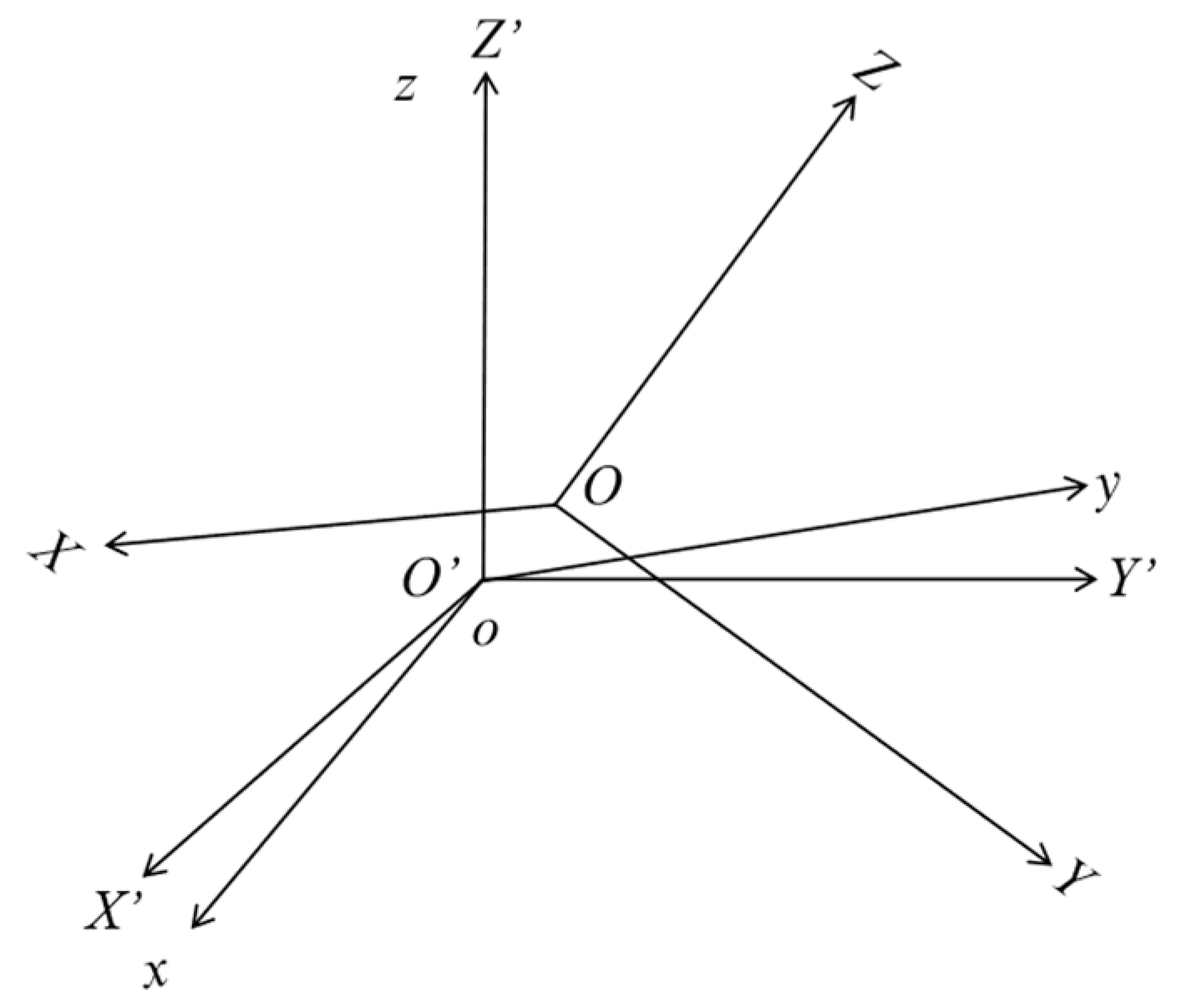
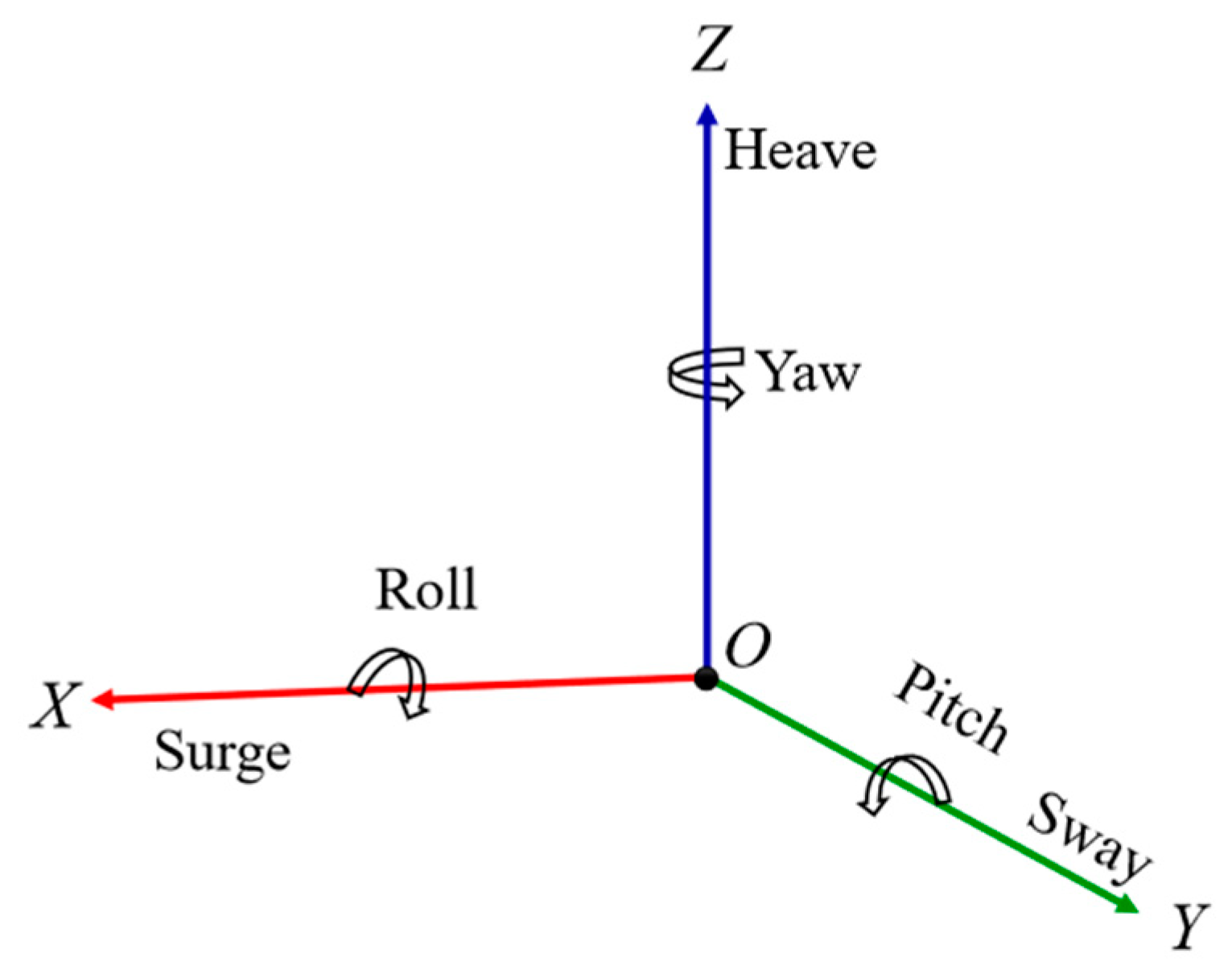

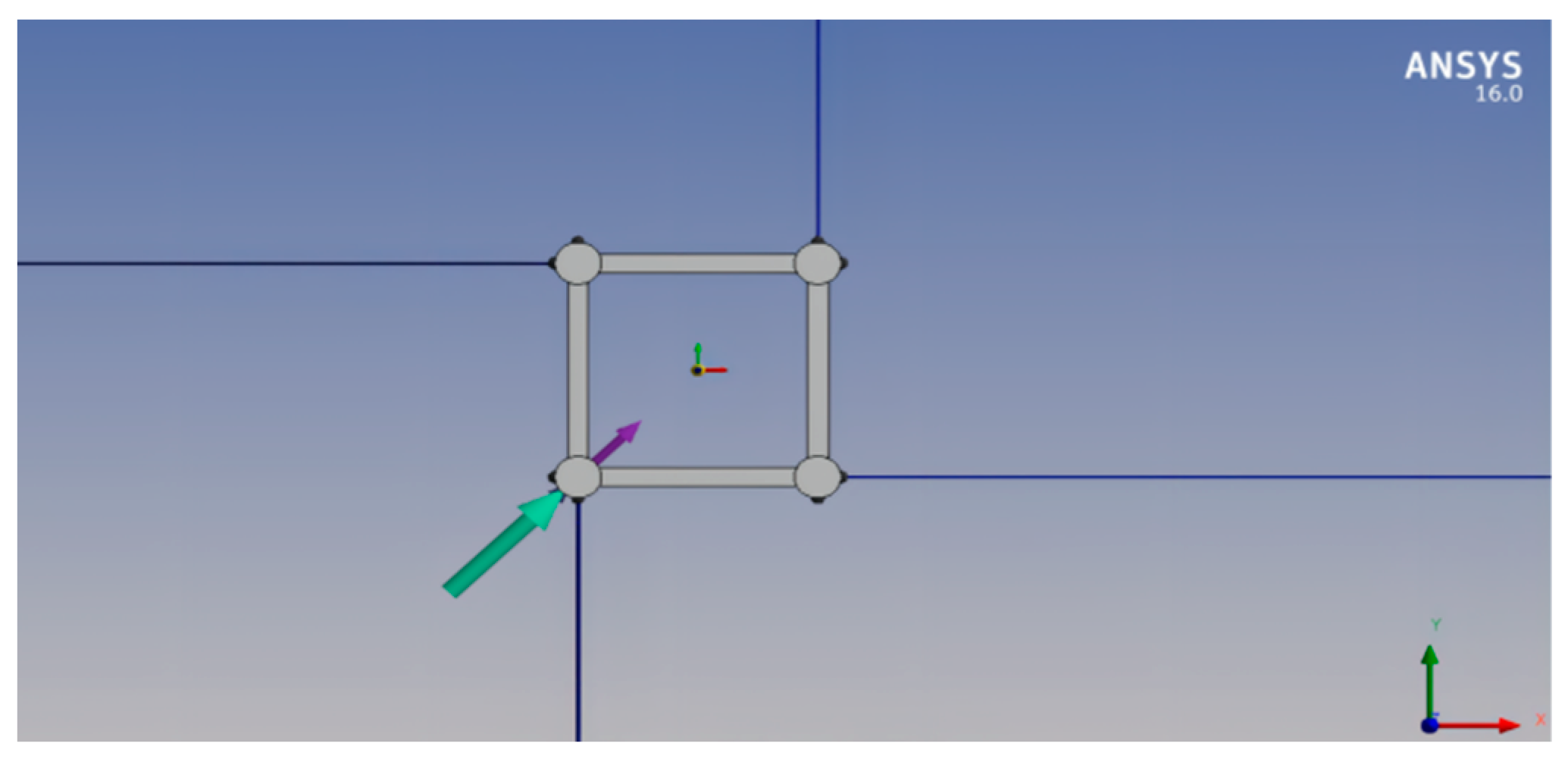

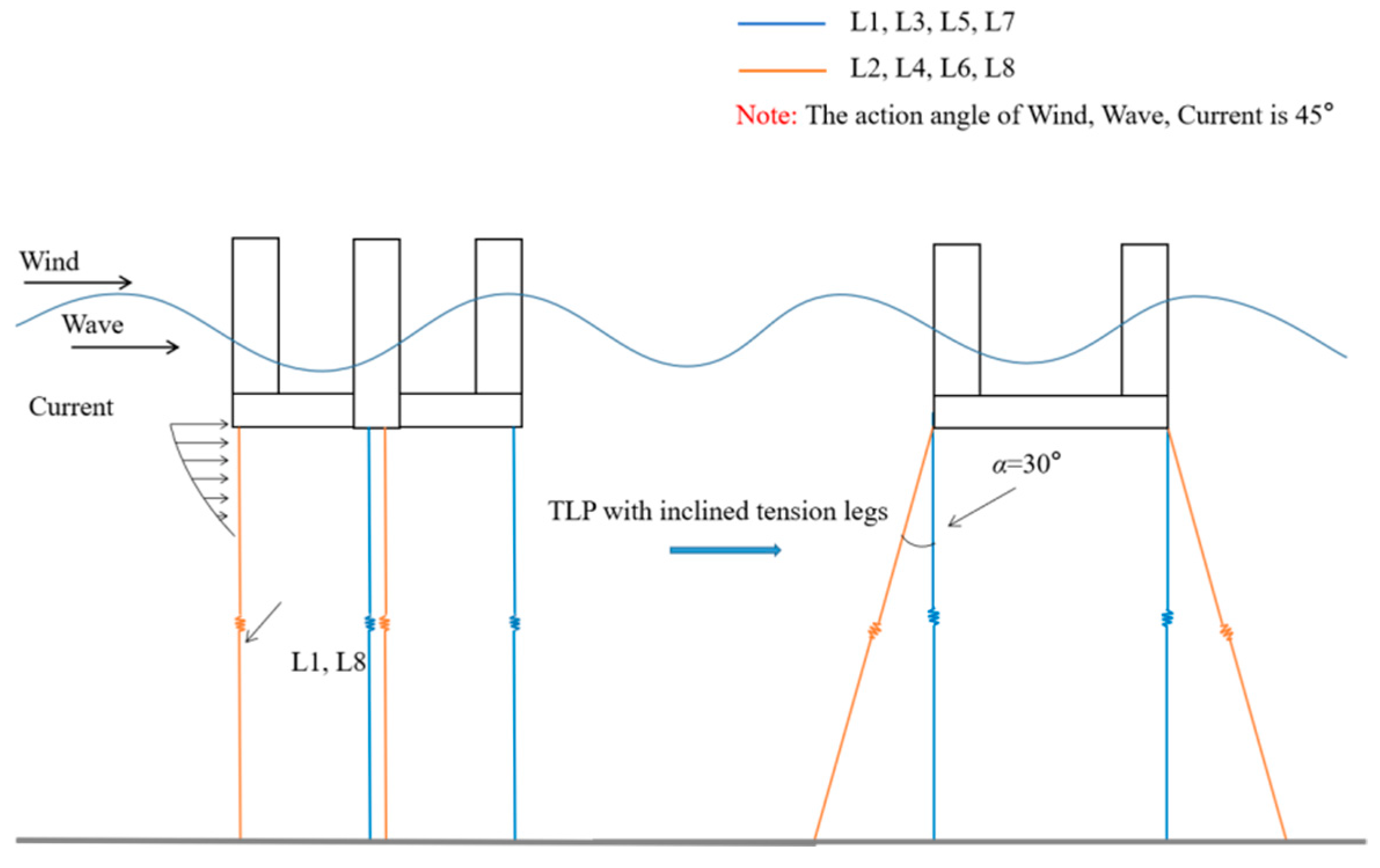
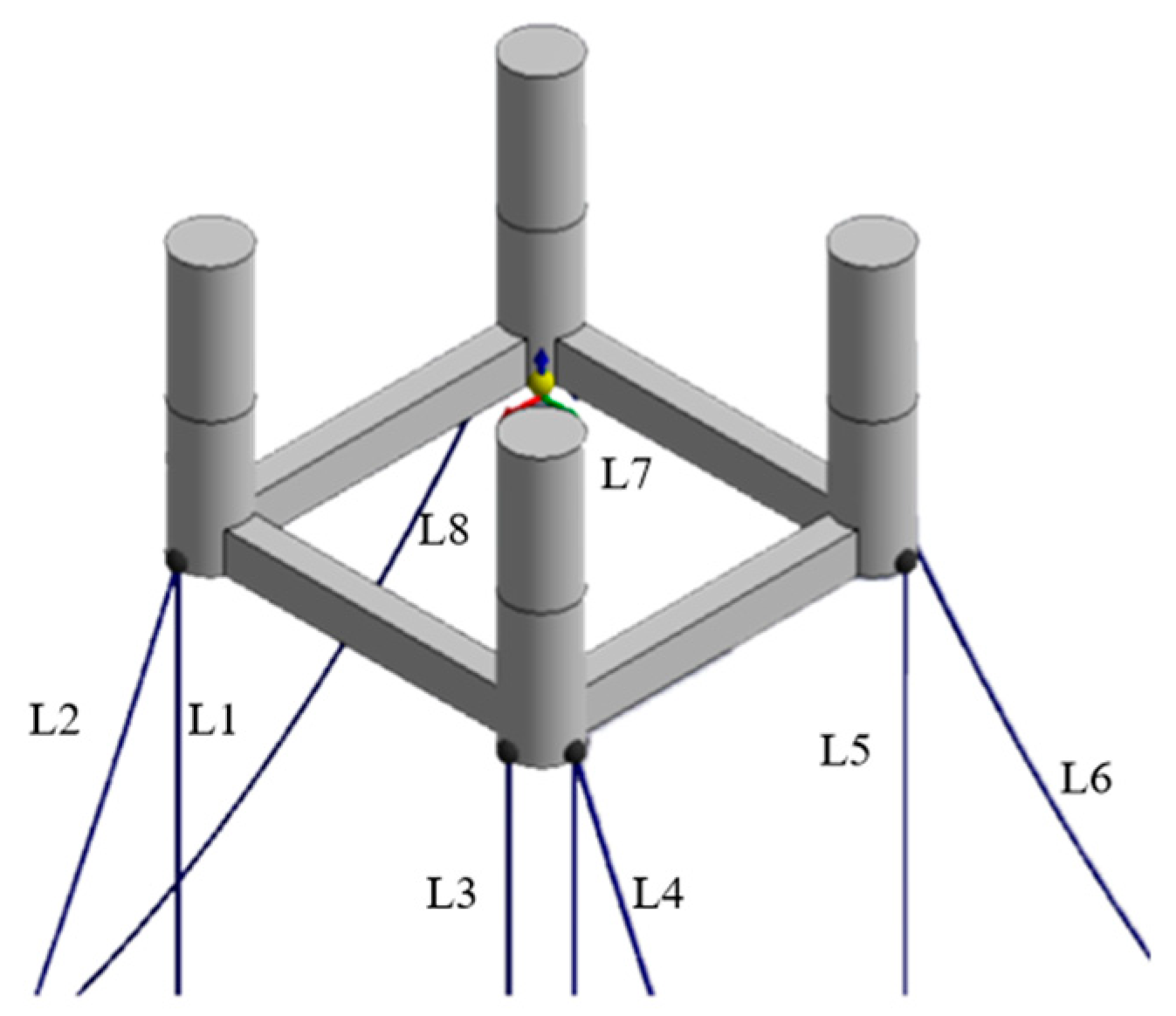

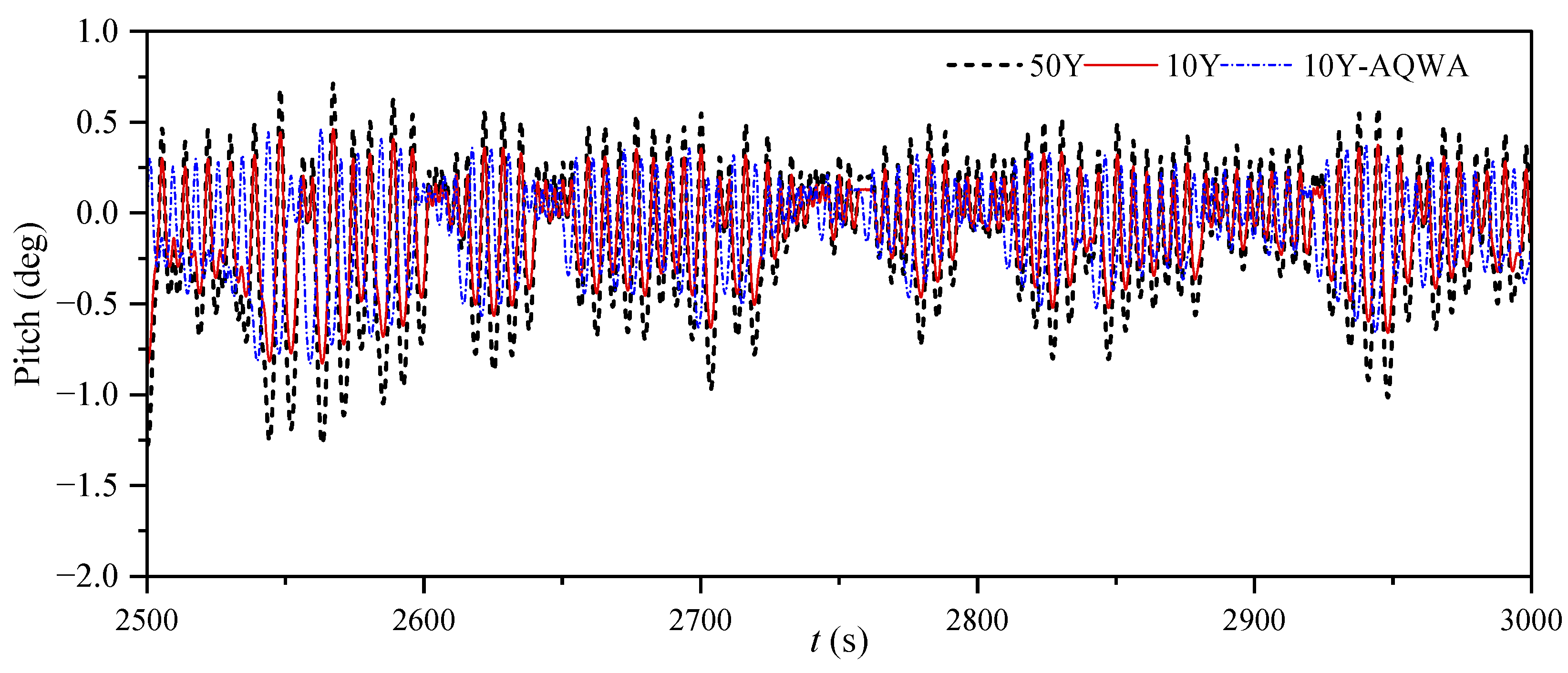

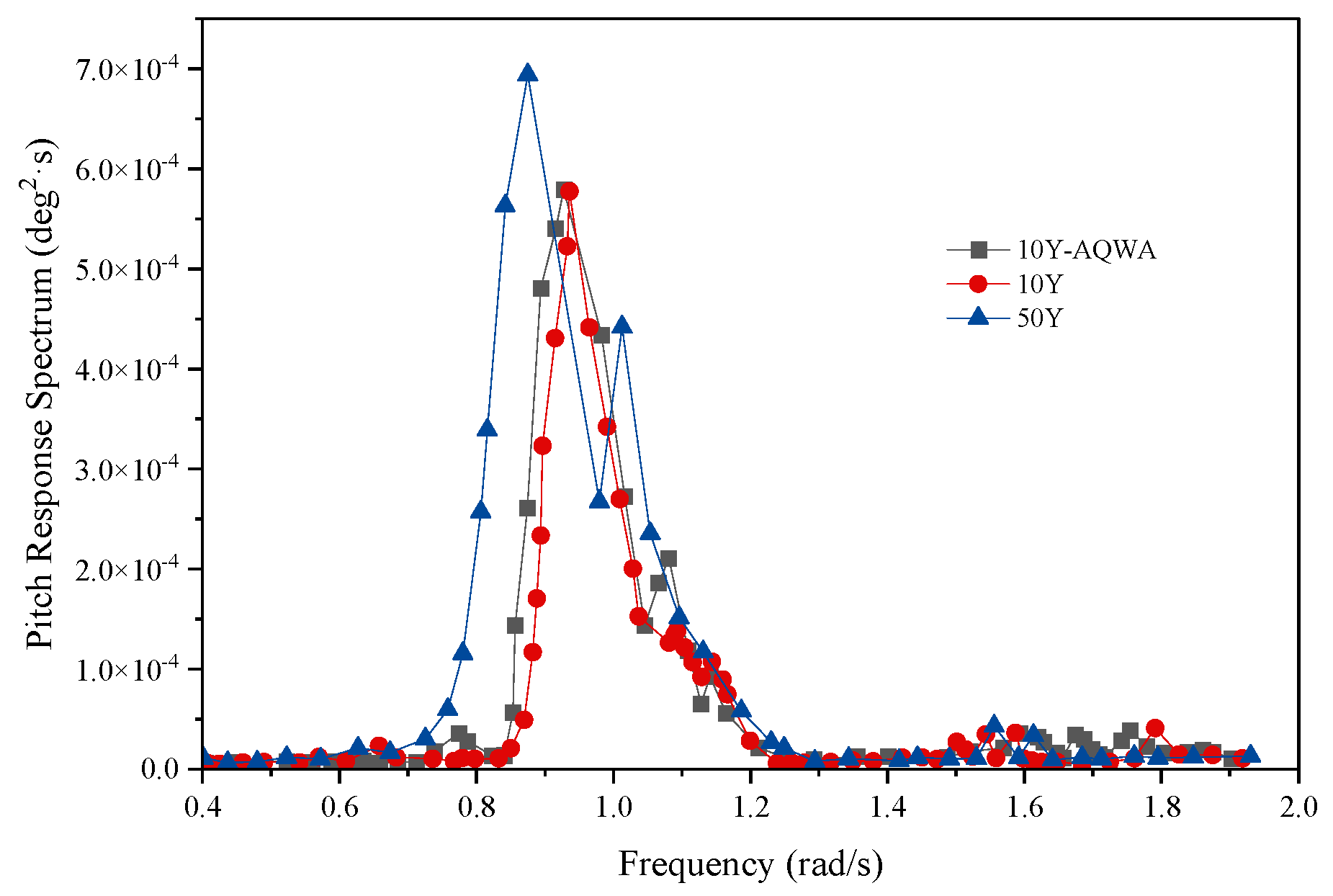
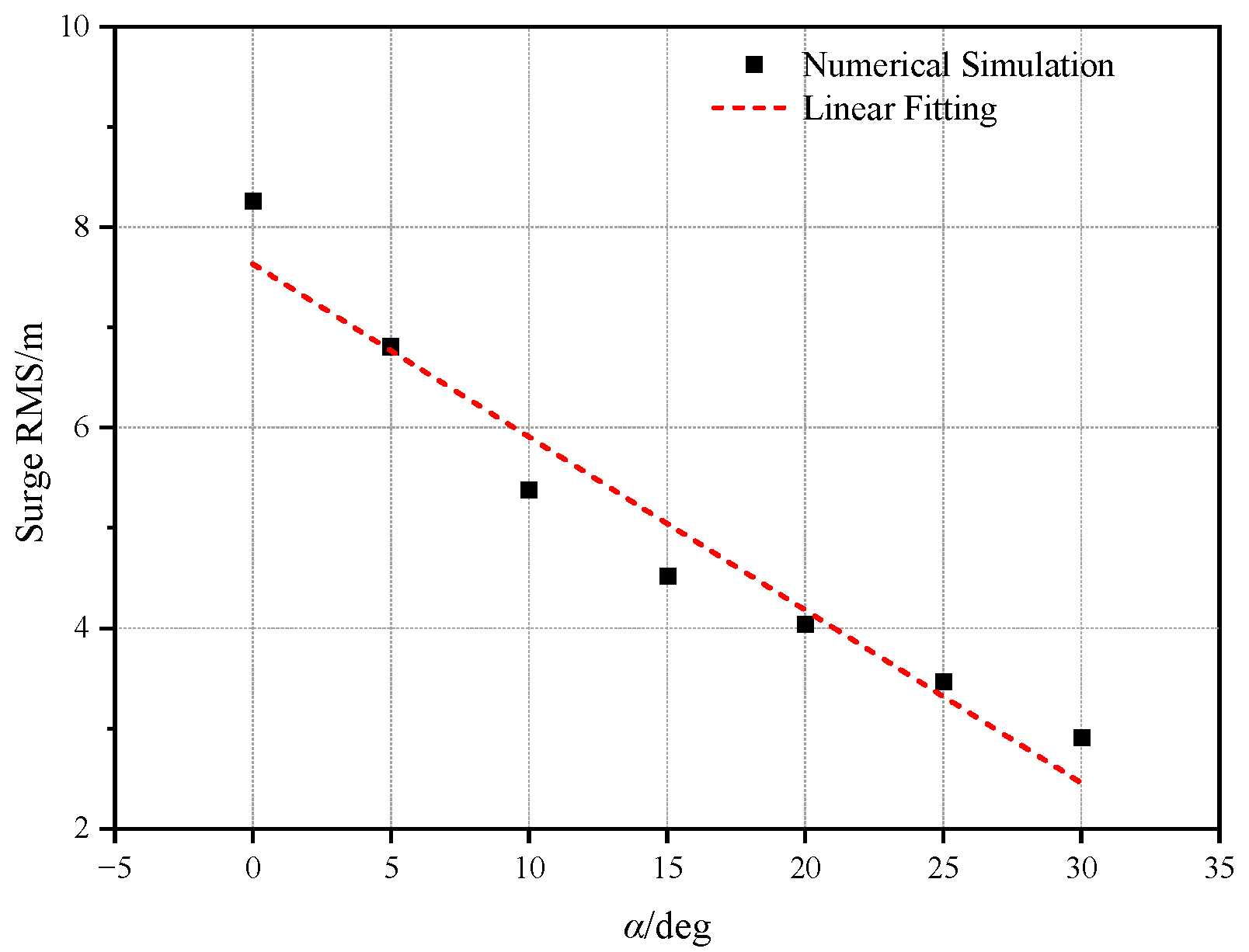
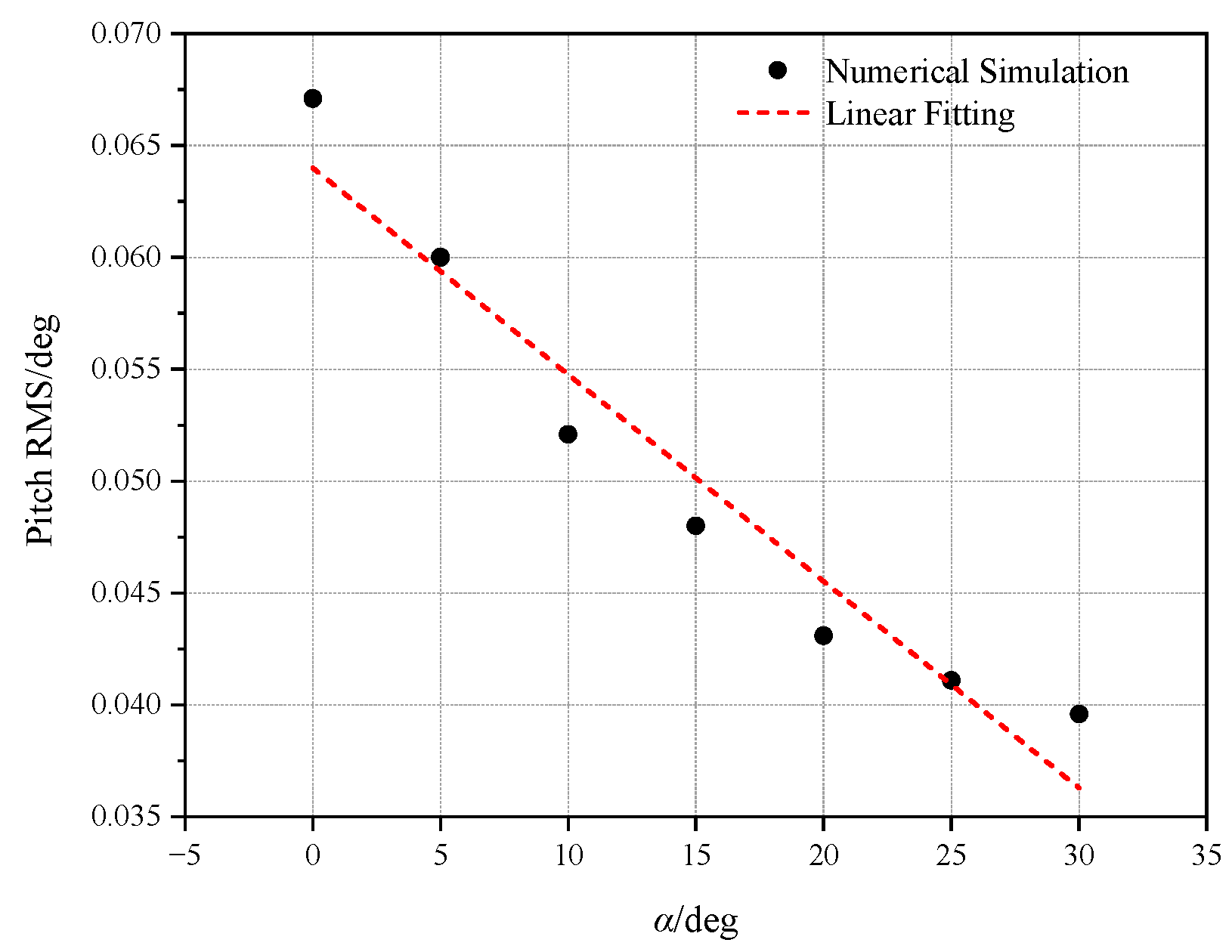
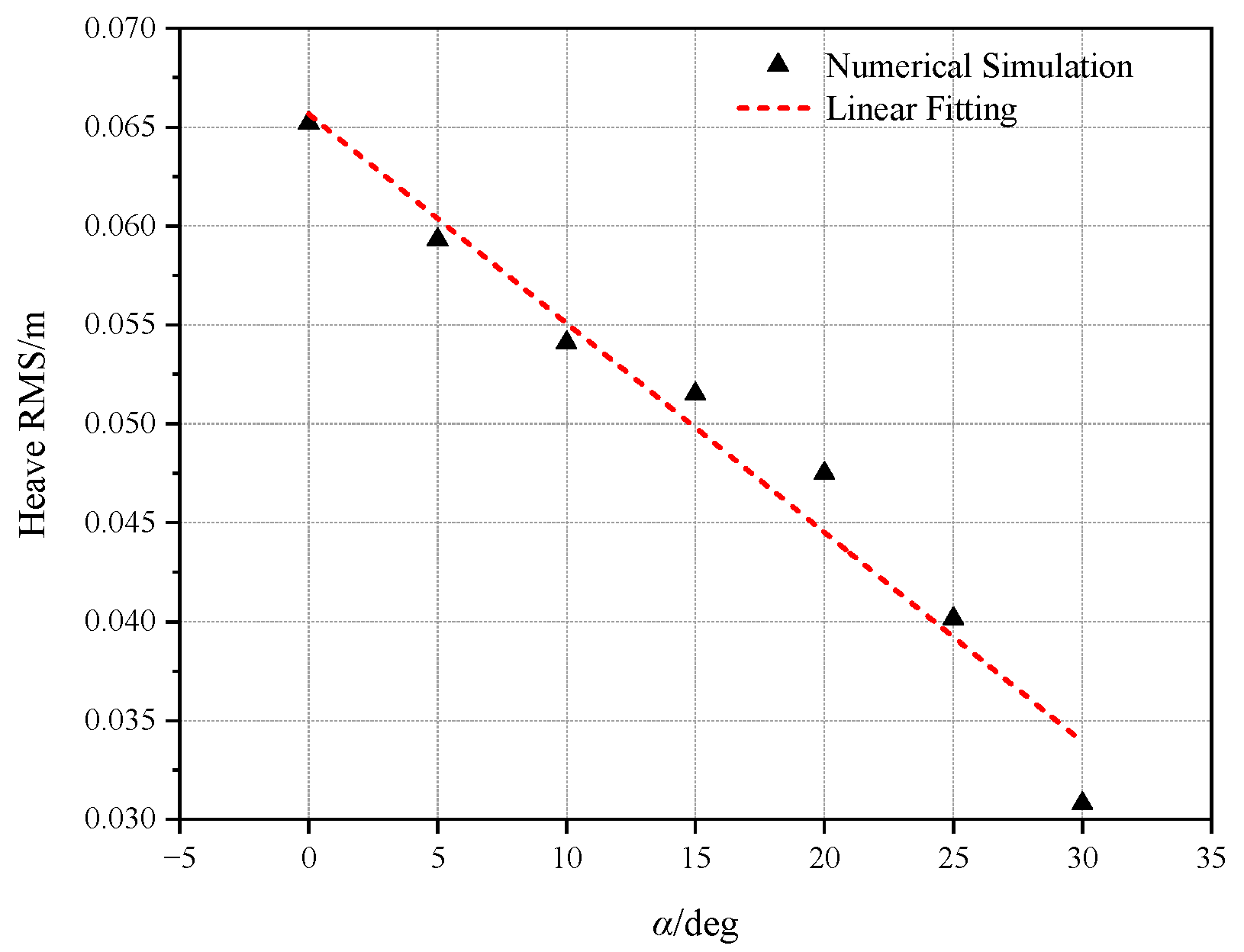
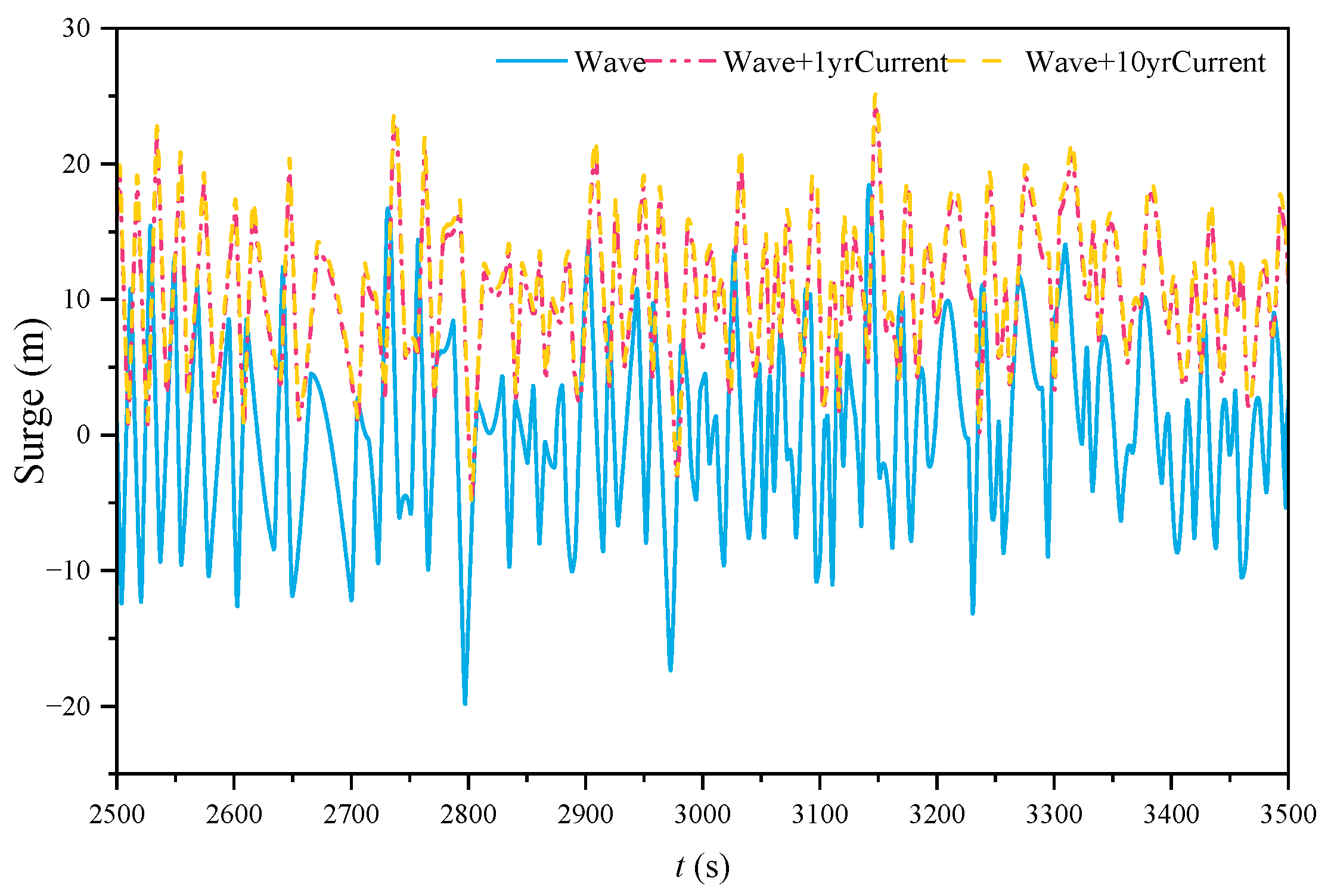


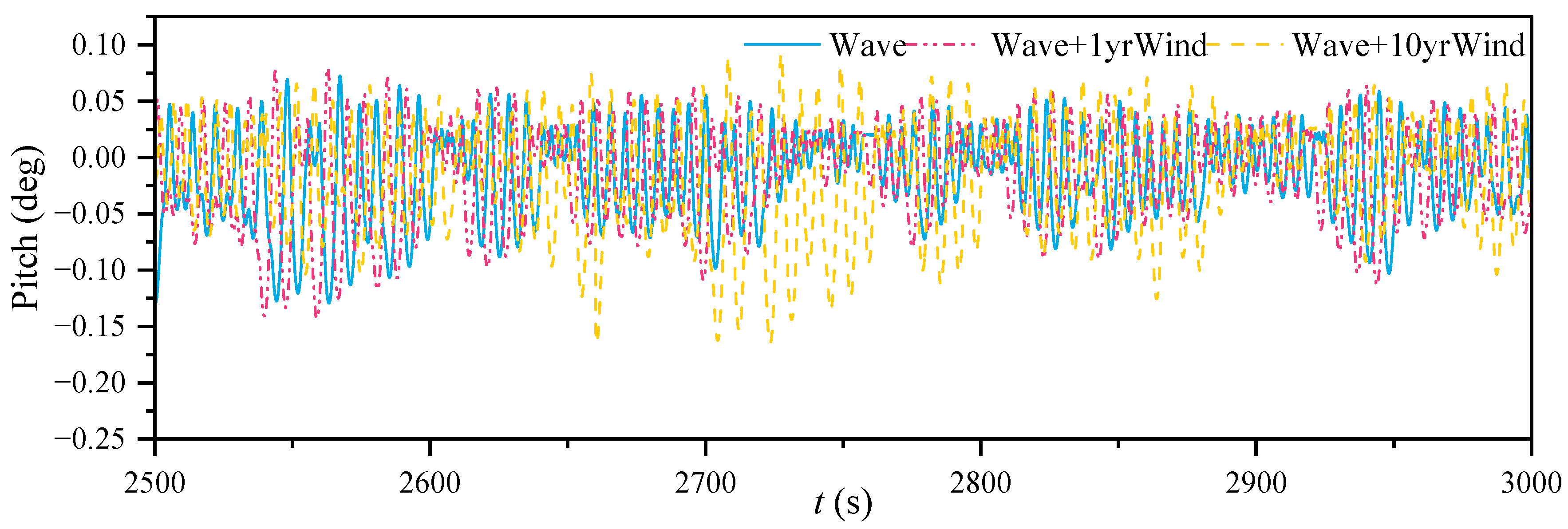
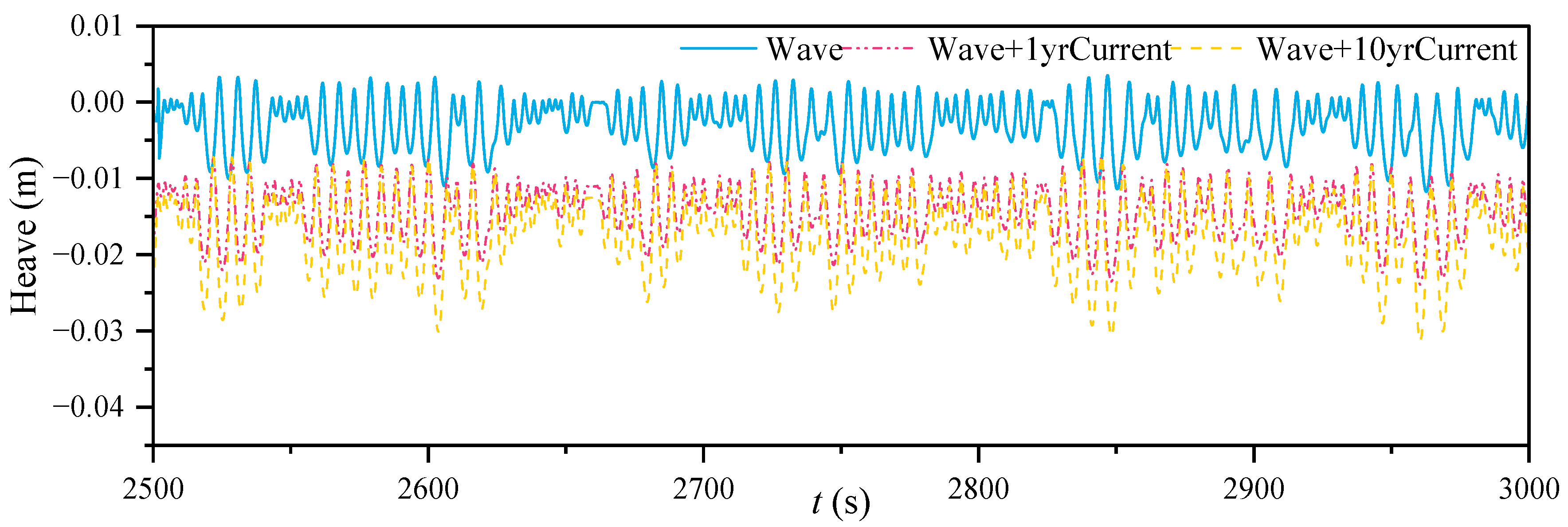
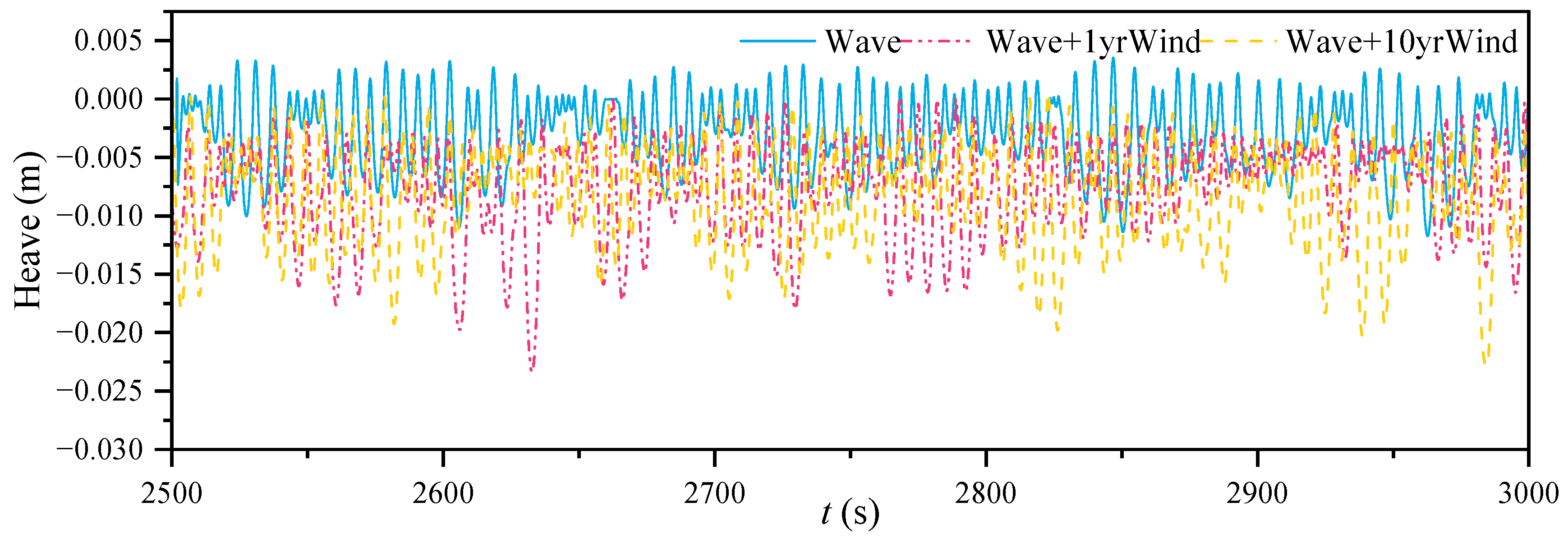

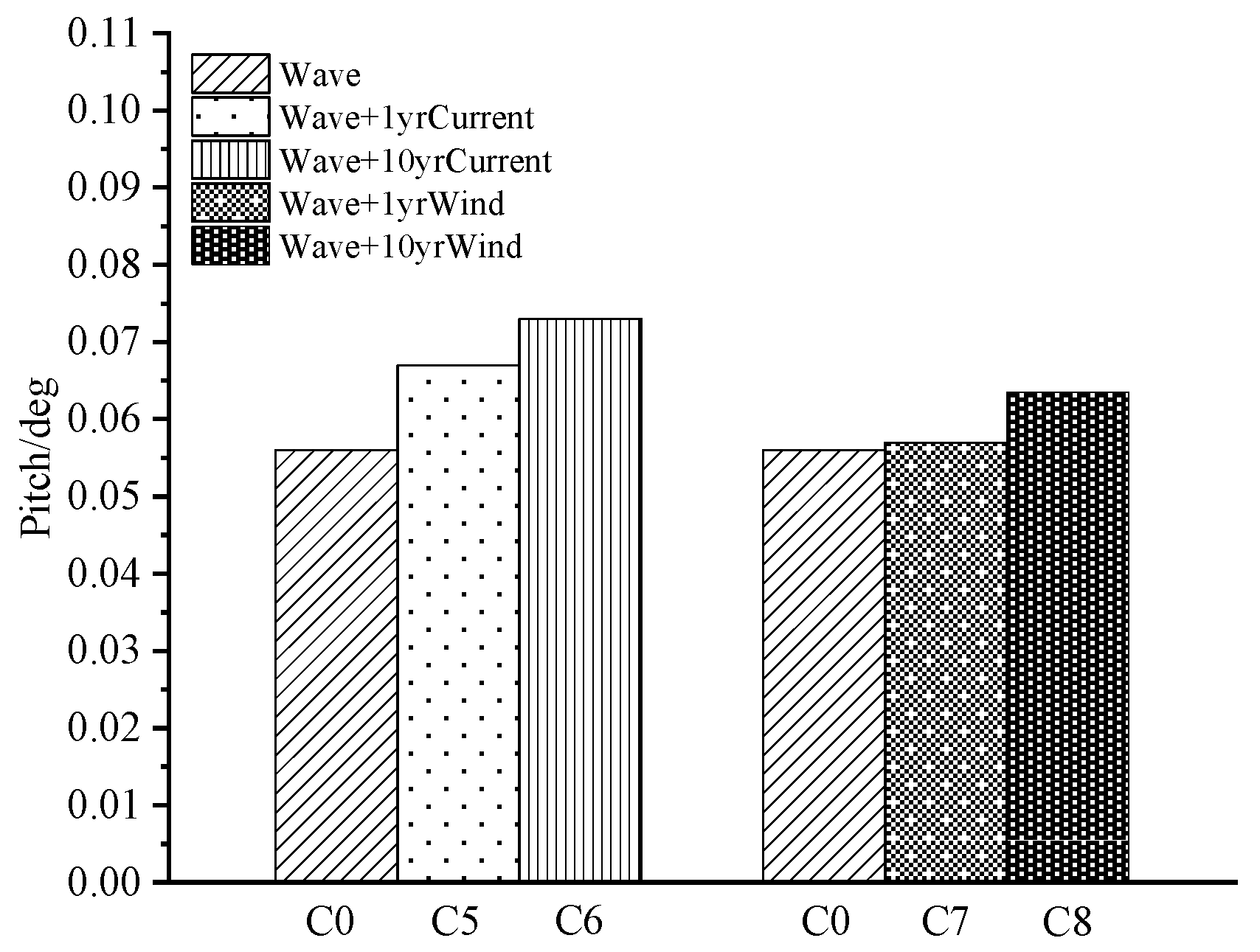
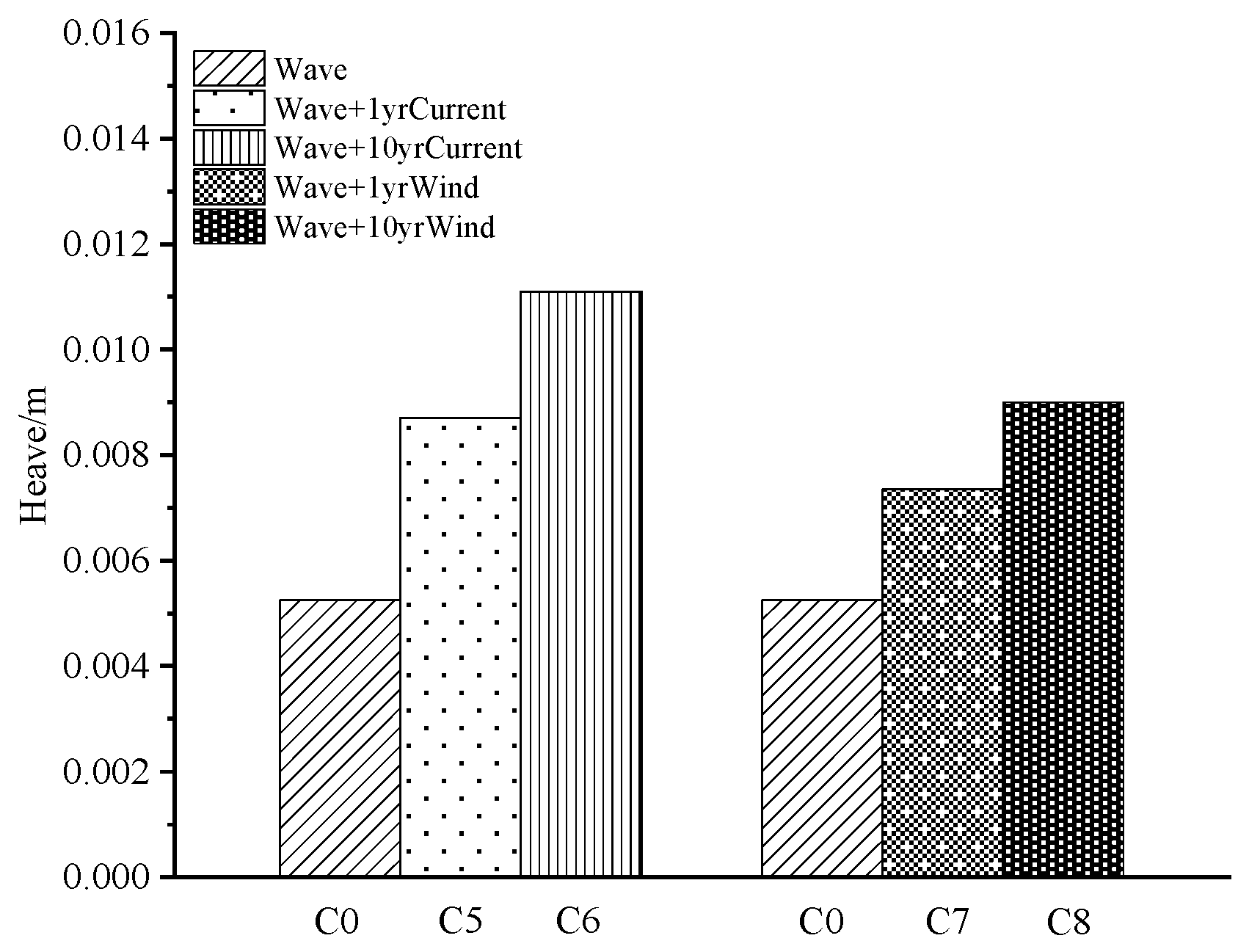
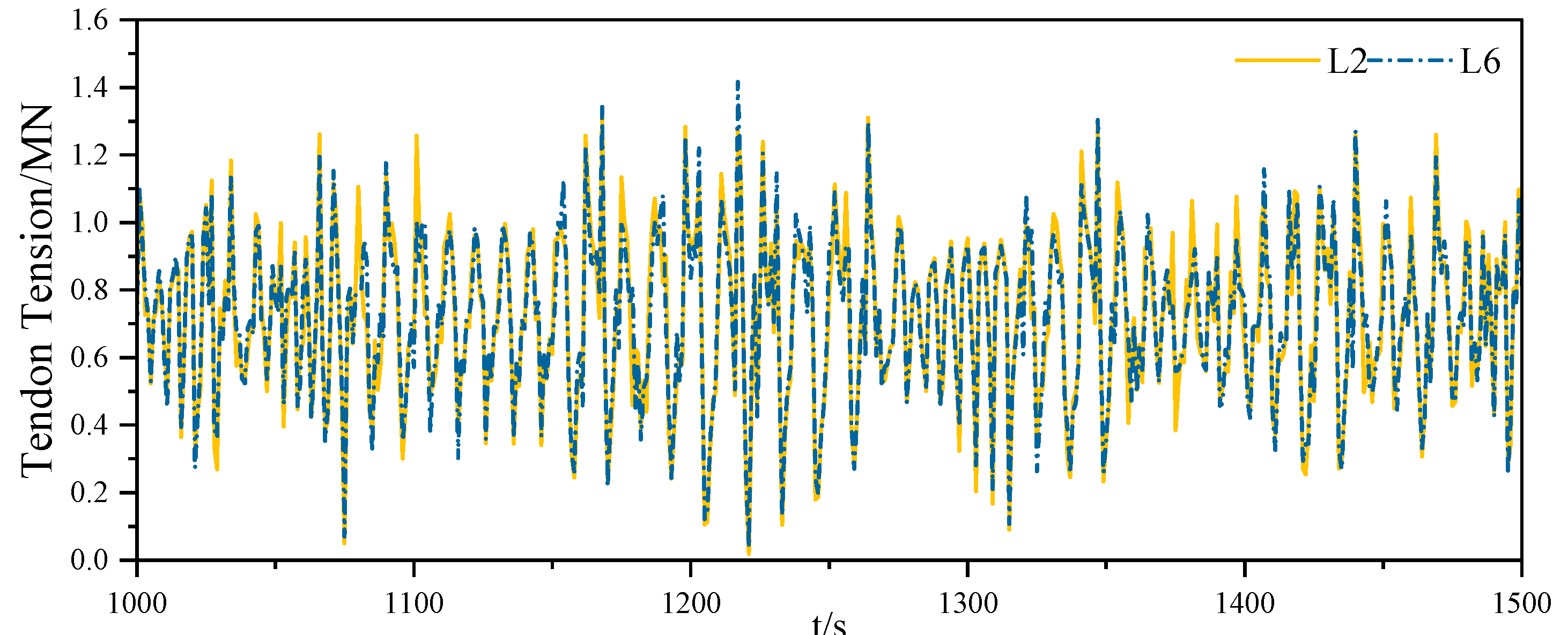

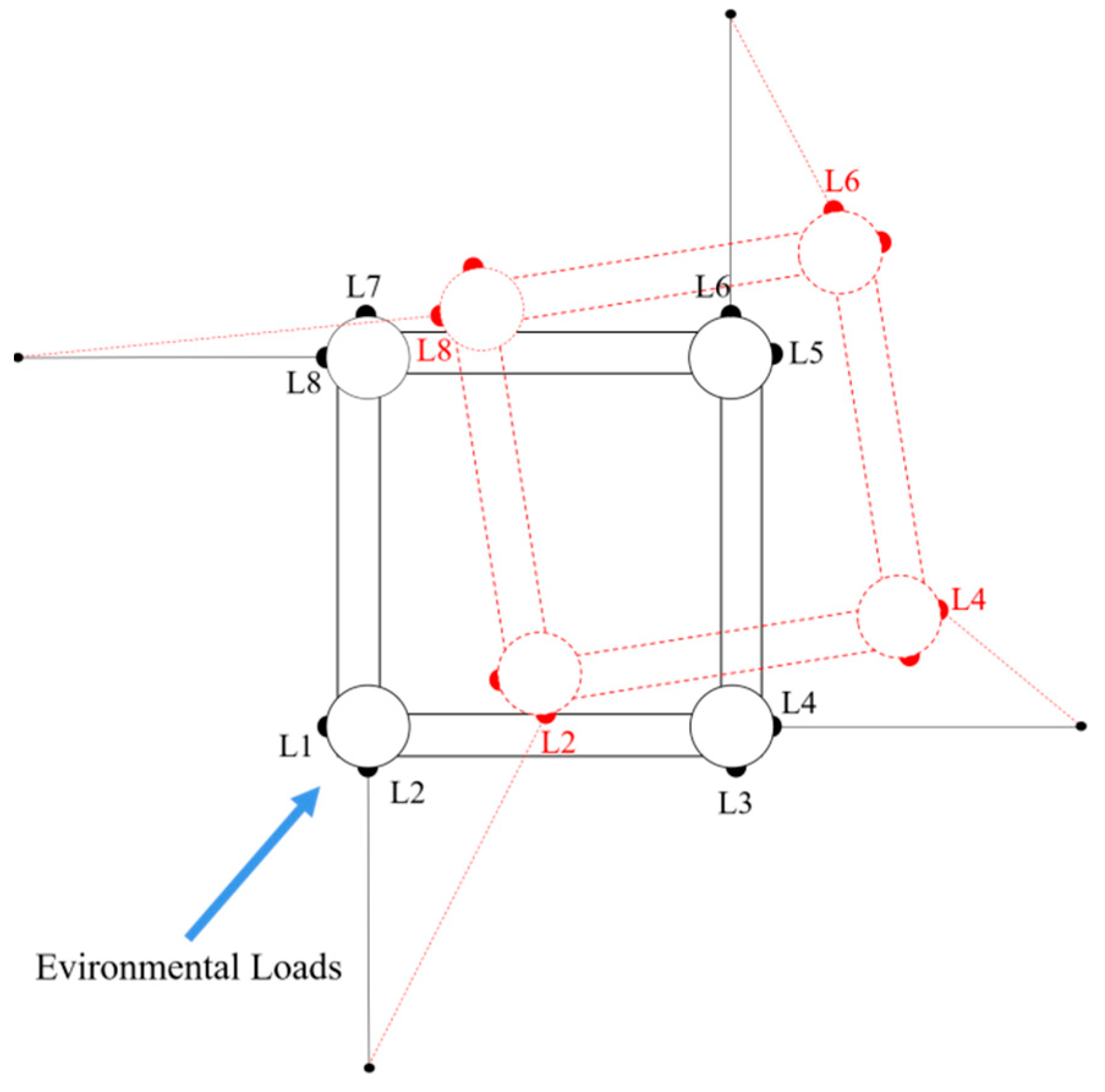
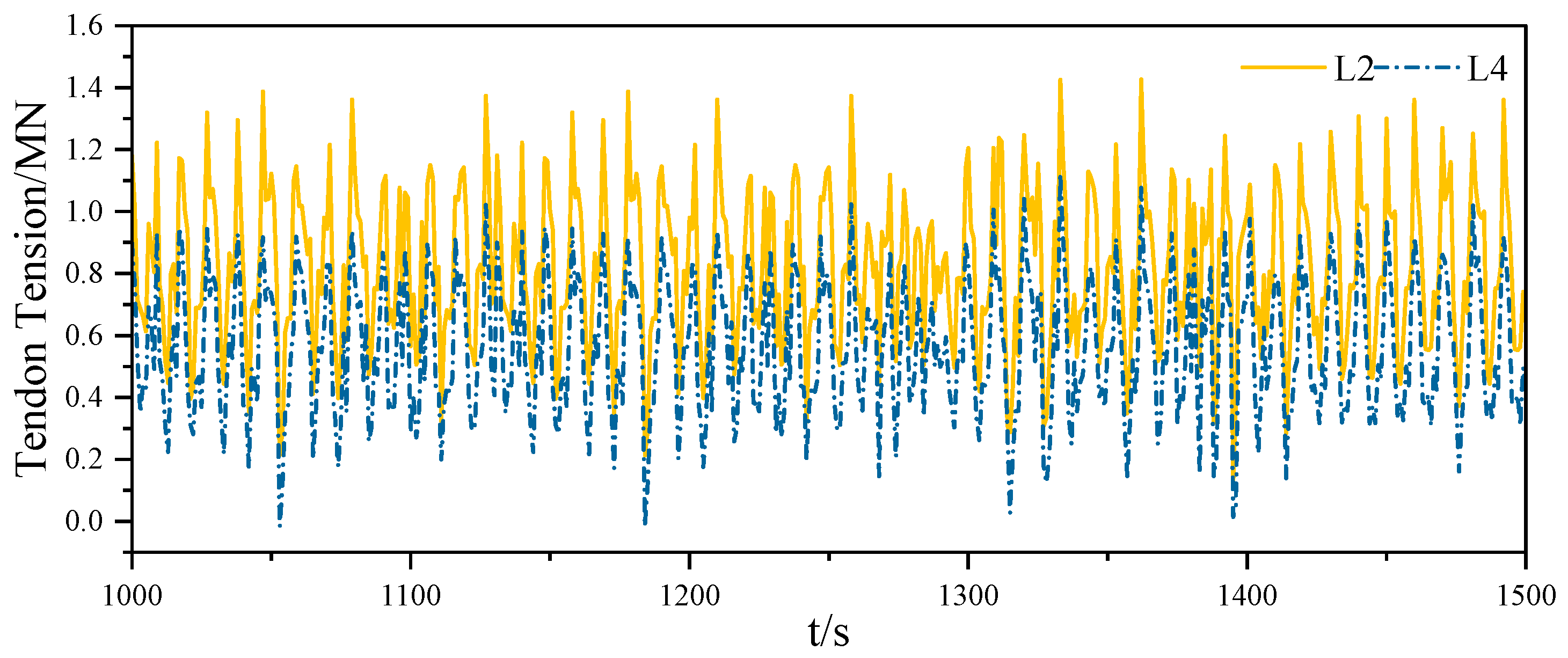
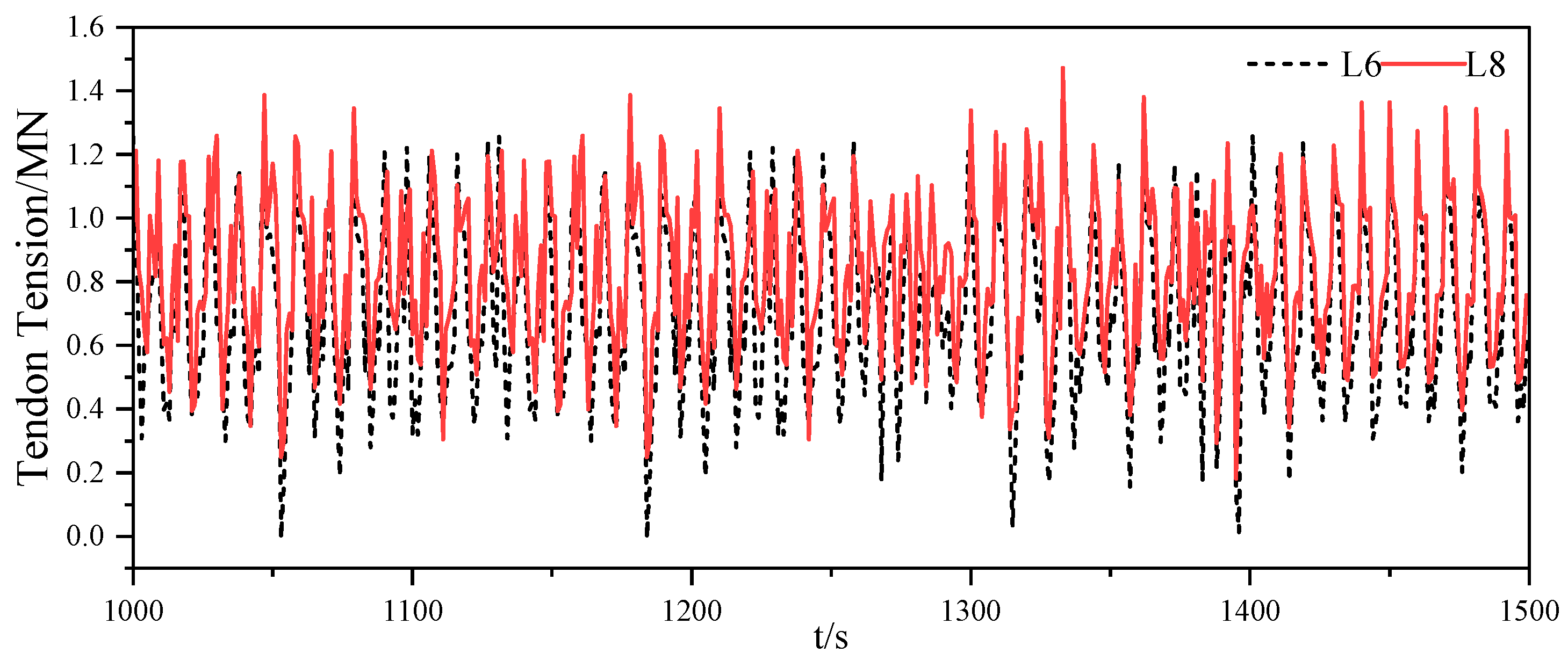
| Surge | Sway | Heave | Roll | Pitch | Yaw | |
|---|---|---|---|---|---|---|
| ωi (rad·s−1) | 0.0612 | 0.0612 | 3.488 | 3.401 | 3.401 | 0.0764 |
| Parameter | Value | Parameter | Value |
|---|---|---|---|
| Column spacing | 86.25 m | Total pretension | 14 × 103 kN |
| Column radius | 8.44 m | Inner diameter of tension leg | 0.3436 m |
| Column length | 67.5 m | Outer diameter of tension leg | 0.8 m |
| Floating box width | 7.50 m | Tendon length | 415.0 m |
| Floating box height | 10.50 m | Kxx | 1.501 × 109 kN·m−1 |
| Displacement | 54.5 × 106 kg | Kzz | 0.819 × 106 kN·m−1 |
| Total mass | 40.5 × 106 kg | Dry weight | 1575.9 kg·m−1 |
| Ixx | 82.37 × 109 kg·m2 | Wet weight | 240.5 kg·m−1 |
| Iyy | 82.37 × 109 kg·m2 | Tendon’s stiffness | 2.28 × 107 kN |
| Izz | 98.07 × 109 kg·m2 | Area of contour vertical to current | 5.019 × 103 m2 |
| EA | 1.335 × 1011 N | Area of contour vertical to wind | 2.194 × 103 m2 |
| Centre of gravity | 38.0 m | Water depth | 450 m |
| Draft | 35.00 m |
| Conditions | Load | Hs (m) | Tm (s) | γ | V (m·s−1) | Vt(0) (m·s−1) |
|---|---|---|---|---|---|---|
| C1 | Wind load | - | - | - | 5 | - |
| C2 | - | - | - | 11.5 | ||
| C3 | Current load | - | - | - | - | 0.8 |
| C4 | - | - | - | - | 1.08 | |
| C5 | Wave load + C1 | 6.8 | 10.2 | - | 5 | - |
| C6 | Wave load + C2 | 6.8 | 10.2 | - | 11.5 | - |
| C7 | Wave load + C3 | 6.8 | 10.2 | - | - | 0.8 |
| C8 | Wave load + C4 | 6.8 | 10.2 | - | - | 1.08 |
Publisher’s Note: MDPI stays neutral with regard to jurisdictional claims in published maps and institutional affiliations. |
© 2022 by the authors. Licensee MDPI, Basel, Switzerland. This article is an open access article distributed under the terms and conditions of the Creative Commons Attribution (CC BY) license (https://creativecommons.org/licenses/by/4.0/).
Share and Cite
Wei, N.; Zhang, Z.; Xu, X.; Yao, W. Stability Analysis of a TLP with Inclined Tension Legs under Different Marine Survival Conditions. J. Mar. Sci. Eng. 2022, 10, 1058. https://doi.org/10.3390/jmse10081058
Wei N, Zhang Z, Xu X, Yao W. Stability Analysis of a TLP with Inclined Tension Legs under Different Marine Survival Conditions. Journal of Marine Science and Engineering. 2022; 10(8):1058. https://doi.org/10.3390/jmse10081058
Chicago/Turabian StyleWei, Naying, Zhen Zhang, Xu Xu, and Wenjuan Yao. 2022. "Stability Analysis of a TLP with Inclined Tension Legs under Different Marine Survival Conditions" Journal of Marine Science and Engineering 10, no. 8: 1058. https://doi.org/10.3390/jmse10081058
APA StyleWei, N., Zhang, Z., Xu, X., & Yao, W. (2022). Stability Analysis of a TLP with Inclined Tension Legs under Different Marine Survival Conditions. Journal of Marine Science and Engineering, 10(8), 1058. https://doi.org/10.3390/jmse10081058





